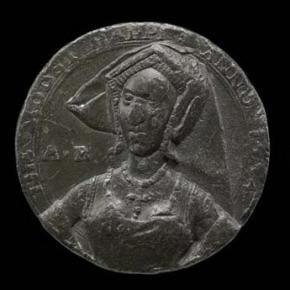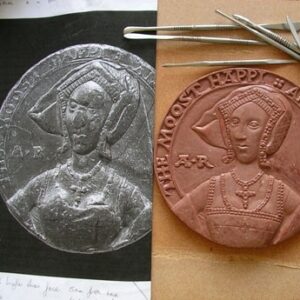Lucy Churchill has just started selling replicas of Anne Boleyn’s 1534 Moost Happi Medal, so I thought it would be good for Lucy to explain how this beautiful replica came to be made. Over to Lucy…
The original Moost Happi medal is a single issue lead prototype of what is believed to be a commemorative coin. It was made in 1534, the year after Henry VIII and Anne’s marriage, her coronation as Queen of England, and the birth of their daughter Elizabeth. Pregnant again, it was confidently presumed that Anne would give birth to a son. However, the pregnancy failed and Anne’s position became increasingly difficult until, in May 1536, she was beheaded at the Tower of London. This small (38mm in diameter) lead disc is a lasting testimony of the time when Anne was at her most secure and triumphant.
My background, and how I became interested in the Moost Happi medal
I began my career working in museums. Daily contact with ancient, beautiful and interesting artifacts gave me itchy fingers and I was inspired to retrain as a stonecarver. Staying close to my roots I specialised in making historically accurate recreations for restoration work. This is both challenging and satisfying as you must learn to read visual clues from eroded or broken fragments. It is also crucial to subdue your own artistic impulses to recreate the authentic style of the object, whether it be Classical, Gothic, or Victorian Gothic (there is a discernible difference, believe me). Furthermore, we are trained to work to an accuracy of quarter of a millimeter.
Working with ancient buildings encouraged my love of history, and in recent years this became increasingly focused on the Tudors – particularly the controversial figure of Anne Boleyn. I was fascinated to learn that there was only one portrait of Anne Boleyn remaining that was made during her lifetime, and whose identity was undisputed: ‘The Moost Happi. Anno 1534’ medal. (British Museum’s Coins and Medals Collection). However, as a portrait its value was dismissed by many historians because of it damaged condition; the soft lead has been compressed and worn in parts. Most noticeable is that one of Anne’s eyes is obscured, and her nose has been flattened. This makes the portrait seem clumsy and gives Anne an ugly appearance.

I inspected the medal in great detail and realised that beneath the superficial damage there remains a great quantity of finely observed and modeled detail. For example, having studied the pattern of the jewels on the billiment of the gable hood and the diamond weave of the cloth, it was possible to identify the very same headdress and necklace (with a different pendant) in Holbein’s portrait of Jane Seymour. The matching necklace, worn by Anne in the medal with a jeweled cross, can also be found in portraits of Catherine Howard and Katherine Parr. It is also the same necklace worn in the disputed Nidd Hall portrait of Anne. With my professional training and personal interest, I felt compelled to take on the challenge of reconstructing the damaged features and issue the medal of Anne Boleyn as she had wanted to present herself.



My research for the medal reconstruction
I made an appointment to view the object at the British Museum where it is now kept in storage. In the meantime I enlarged the photograph of the medal which is on the museum’s database. Using a light-box I traced those features which could still be seen, resulting in an accurate template of the coin in its current state. I took multiple copies of this line drawing with me to the British Museum, plus measuring equipment such as calipers, dividers and sinking squares – and a very powerful magnifying glass. With the original medal in my hand I annotated copies of the line drawings with written measurements, shading and numerous notes to record its three-dimensional appearance.

Holding the lead medal in my latex-gloved hand was a powerful and moving experience; Eric Ives wrote ‘Such a piece can only have been prepared on royal authority.’ (‘The Life and Death of Anne Boleyn’, Chap 3, pg 31). It is possible that Anne never actually saw this lead version of her portrait. However, knowing that she paid meticulous attention to detail regarding her public presentation, it is plausible that she would have inspected this prototype of the medal. I felt very conscious that I had to do my very best with the reconstruction – not just to record the details in a professionally accurate manner, but to capture the spirit of its original, so that it would be seen as Anne intended.
The reconstruction process
Armed with first hand information, I set about recreating the object. I decided to reconstruct the medal at four times the original scale, so as to display its features more clearly. At this stage I was motivated solely by personal curiosity and had no intention to make copies to sell. Therefore it was a personal decision based on what would look best on my desk, or mounted nearby on the wall. In this my original intention has been fulfilled and while I do my deskwork, Anne’s smiling face inspires me daily.
Using a needle to prick holes along the traced lines of the medal, I was able to accurately transfer the information onto a rolled out disk of modeling wax. This gave me a ‘footprint’ which I could then build onto using tiny wooden and metal sculpting tools and my fingers. I referred to the notes and sketches I had made at the British Museum to guide me regarding the relative height of the modeled features. Despite working at a larger scale than the original sculptor, it was a challenging task. Unlike the original sculptor, I had the advantage of being able to work with powerful magnifying equipment. However, the heat of the lamp softened the wax so I had to take care not to inadvertently touch (and damage) areas that were already complete.

When the reconstruction was finished I took it to Steve Cole at Articole Studios – www.articolestudios.co.uk – who coated the wax model with silicon rubber. This made a negative form which captured every detail of the modeled form, so that copies could be made in a more durable material. It was incredibly exciting to come back a few weeks later and to be able to hold the reconstruction, now cast in bronze resin, in my hands.
Critical responses to the Moost Happi reconstruction
I was elated that historians such as Alison Weir and David Starkey praised the authenticity of my reconstruction. However, the response that meant the most to me came from the late historian Eric Ives; “Lucy Churchill’s brilliant achievement has brought us as close to the real Anne Boleyn as we shall ever be able to get.”
I hope very much that Anne would approve and be satisfied that her Moost Happi medal has been issued at last.
Lucy Churchill, BA (Hons)
November 2012
Cambridge, England.
Lucy’s replica medal is available at – http://www.lucychurchill.com/MoostHappyBuynow.php.